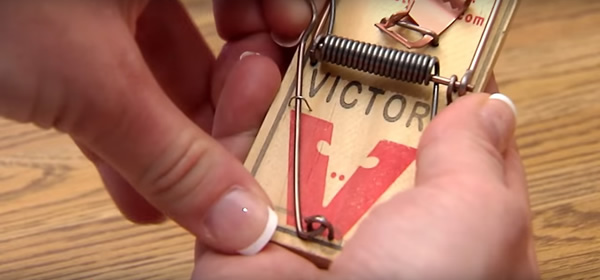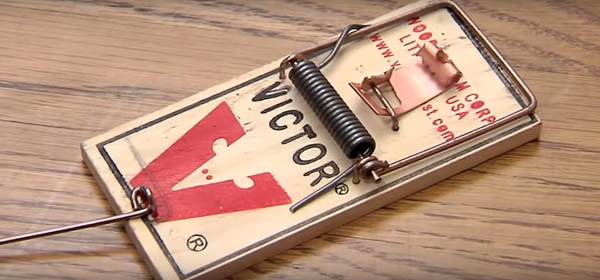Step 1: buy mouse traps
The first thing you should do is choosing the type of mouse trap you will use. The most famous and common type is snap trap - the one with wooden base and spring that snaps down metal mechanism. This is cheap and reliable product, that is often sold in packs of 6, what could be a great deal for those, who have serious troubles with mice. In addition, there are electronic, glue and live-catch traps are available.
Traps can also be disposable and reusable. Disposable ones are more expensive option, since they require buying new trap for every mouse, but they allow to avoid dealing with dead mice, what can be a problem for someone.
Step 2: buy gloves
In case you don’t have gloves, it is highly recommended to buy them before handling with mouse traps. Since mice detect scents pretty well, your smell on bait and trap may sometimes scare them away, so it will be better to use gloves when you set a mouse trap. But the main reason is that mice carry dangerous diseases, so it is necessary to use gloves in order to protect yourself from infection, when removing dead mice from reusable traps.
You can take any medical or industrial safety gloves, just don’t forget to get rid of them after handling with dead mice.
Step 3: find all mouse locations
The next step is one of the most important. It requires a quick eye, attention and understanding of mice behaviour. You should locate all rodent zones in your house, where mice nest and eat, as well as their routes between these areas. Look for such signs as holes in the walls, footprints, droppings, urine pillars, grease marks and strong ammonia-like smell. At night, listen for scratching noises and the pitter-patter.
The most popular locations of mice are: garages, attics, basements, secluded corners, ceiling or wall voids, various crawl spaces, places near heat sources, between furniture and under cabinets etc.
Step 4: prepare bait
Contrary to popular belief, cheese is not the best bait for mouse traps. Mice like seeds and nuts, so you need some food that has strong smell of this kind to attract them. Peanut butter is considered the best choice, but other products such as hazelnut spread are also good. Snap traps need baits that stick to their triggers instead of just lay on them in order to not let mice just pick up bait and run away, so using some kind of butter is highly recommended, if you set a snap trap.
For other types of traps, when you need to just lure mice, you can use sunflower seeds, chocolate and even inedible materials that mice use to build nests, such as yarn, twine, cotton balls etc.
Step 5: set the trap
Victor® Metal Pedal Mouse Trap is used as example to explain how to set a mouse trap.
Open the package and take the mouse trap. You will see the arm bar fixed with a staple.

Release it and move to the back, thus making it hanging over the trap.


Take a small amount of bait you have prepared in previous step with a toothpick, Q-Tip, knife or any other tool that will mask your scent and place it on the bait pedal on the trap.

There are few important things you should know. First, you should not place big amount of bait, because mouse can just lick it without pressing the pedal. Second, make sure that the bait is stuck to the pedal and it will not fall, when mouse will touch it. And finally, if you have noticed, that your mice are too smart and eat your bait without triggering the trap, there is a trick that will help you. Before placing the bait, take some dental floss, loosely wrap it around the pedal and tie. After that, place a small amount of bait again. Now, when mouse will eat the bait, it will pull the dental floss thus pressing the pedal and the trap will get triggered for sure.
After you have placed the bait, take the kill bar, pull it back and hold with your thumb.

Next, take the arm bar and put it on the kill bar.

Latch it into the notch you see on the pedal with bait.

Now you can release the kill bar very slowly. Make sure that the notch really holds the arm bar, otherwise the kill bar can hit your fingers very hard.
Step 6: place it
The main reasons why people fail in getting rid of mice are using not enough traps or placing them in wrong locations.
It is highly recommended to use several mouse traps even if you have only one or few mice in your house. Placing them in different locations will greatly increase your chances to catch the rodents. In case you have big infestation, you may need dozens of mouse traps placed all over your house.
Put them on the mice ways near previously located rodent zones. Mice don’t like open areas and prefer to move unnoticed, so they usually run along the walls and near or under the large objects, such as cabinets or sofas. It is recommended to place traps 2-3 feet from each other and sometimes even in pairs.
If you have kids or pets, try to place mouse traps in hidden areas, so they won’t harm any of them by accident.
When setting traps along the walls, make sure to place them right near wall, so they block the way and force mice to explore them instead of just passing by. The end with bait must always face the wall, so mouse could discover the food in the first place.

Step 7: check your traps regularly
You should check all you mouse traps at least daily, but doing this 2-3 times a day will be much better.
If you are using some kinds of humane traps, that don’t kill rodents, you should release them as soon as possible before they died of hunger, dehydration or suffocation. If you have some device that can trap several mice together, it is even possible that they can eat each other after staying long time in closed space. So, if you want to keep them alive in order to release them into the wild, check traps as often as possible.
Using kill traps also requires regular checking, because after some time dead mice will start stink , decompose and spread harmful bacteria. Don't forget that mice carry dangerous diseases, so quick removal of dead mice from your house will prevent you, your family and pets from various infections.
In addition, for both kinds of traps, humane and kill, even if they didn’t work, you should regularly check baits to make sure they still there. In case you use some butter as a bait, it is recommended to change it from time to time, because fresh butter will smell stronger and attract rodents better. Also, if the trap cannot catch mouse during long time, you may try another bait or move it to another location.
Step 8: dispose the mouse
When the mouse is trapped, you should get rid of it immediately. Don’t forget to use gloves in this step to protect yourself. Make sure the rodent is really dead, because if it’s still alive, it might be dangerous. If so, don’t touch mouse itself, take it along with the trap.
You may want to release it somewhere in the wild, but don’t forget that it can come back to your house, so make sure you’ve gone away far enough. Mice have perfect navigational instinct, some of them can return after being released more than a mile from the house, so you need to go at least 2-3 miles away.
Sometimes alive mouse is seriously injured and suffers, so there is no point to release it. In this case, it is better to just kill it in order to stop its suffering. The best option here is to drown it in a bucket with water.
But in most cases, it will be dead, so you will need just lift the kill bar of the mouse trap over your garbage bin and let it fall into it.
Step 9: place the trap back
Once you did this, set the mouse trap again and place it back to its previous location. There still may be other mice in your house, so you should be on the alert. The fact that the rodent was caught means that you had set a mouse trap properly and in the right place. Don’t remove your traps until you absolutely sure that there are no more rodents left in your house.
Don’t forget that mice are breeding very fast, so you should start your fight against them as soon as you have noticed the very first signs of their presence in your house. It is recommended to have few traps prepared in advance for such cases, and to get rid of mice immediately after they appear without giving them the slightest chance to damage your property.
0 comments:
Post a Comment
Note: Only a member of this blog may post a comment.